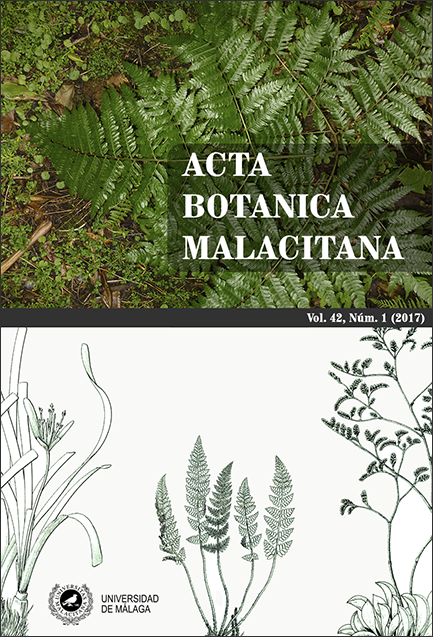Antimicrobial activity of ethanolic and aqueous extracts of medicinally used tree ferns Alsophila cuspidata and Cyathea microdonta
DOI :
https://doi.org/10.24310/abm.v42i1.2885Résumé
Medicinal plants are important components of traditional medicine and sources of novel antimicrobial compounds against drug resistance pathogen strains. This study tested the antimicrobial activity of ethanolic and aqueous extracts of medicinally used Neotropical tree ferns Cyathea microdonta and Alsophila cuspidata against gram positive bacteria and gram negative bacteria using the Kirby-Bauer disc diffusion method. Highest antimicrobial activity was observed in ethanolic extracts, and extracts were more active against gram positive bacteria than gram negative bacteria. No difference was observed in antimicrobial activity between species or between extracts made from the leaves, stipe, or caudex. These results suggest that the traditional use of tree fern mucilage as a topical agent for cuts and leishmaniasis lesions may reduce risk of secondary infection with skin bacteria such as Staphylococcus aureus, and that Neotropical Cyatheaceae are a potential source of novel antimicrobial compounds.
Téléchargements
Métriques
Références
Ahmad, I., Mehmood, Z. & Mohammad, F. (1998). Screening of some Indian medicinal plants for their antimicrobial properties. Journal of Ethnopharmacology 6(2), 183-193.
Bauer, A.W., Kirby, W.M., Sherris, J.C., & Turck, (1966). Antibiotic susceptibility testing by a standardized single disk method. American Journal of Clinical Pathology 45(4), 493-496.
Bjarnsholt, T., Jensen, P.O., Rasmussen, T.B., Christophersen, L., Calum, H., Hentzer, M., Hougen, H.P., Rygaard, J., Moser, C., Eberl, L., Hoiby, N., & Givskov, M. (2005). Garlic blocks quorum sensing and promotes rapid clearing of pulmonary Pseudomonas aeruginosa infections. Microbiology. 151(12), 3873-3880
Chiller, K., Selkin, B., & Murakawa, G.J. (2001). Skin Microflora and Bacterial Infections of the Skin. Journal of Investigative Dermatology Symposium Proceedings. 6(3), 170–174.
Cowan, M.M. (1999). Plant products as antimicrobial agents. Clinical Microbiology Reviews. 12(4), 564-582 Dimayuga, R.E., & Garcia, S.K. (1991. Antimicrobial screening of medicinal plants from Baja California Sur. Mexico. Journal of Ethnopharmacology. 31(2), 181-192.
González-Lamothe, R., Mitchell, G., Gattuso, M., Diarra, M.S., Malouin, F., & Bouarab, K. (2009). Plant antimicrobial agents and their effects on plant and human pathogens. International Journal of Molecular Sciences. 10(8), 3400-3419.
Eloff, J.N. (1998). Which extractant should be used for the screening and isolation of antimicrobial components from plants? Journal of Ethnopharmacology 60(1), 1-8.
Gurib-Fakin, A. (2009). Medicinal plants: Traditions of yesterday and drugs of tomorrow. Molecular Aspects of Medicine. 27 (2006), 1-93.
Hammer, Ø. & Harper, D.A.T. (2006). Paleontological Data Analysis. Blackwell.
Johnson, M., P., Raja, D., Irudayaraj, V., & Janakiraman. (2012). Antimicrobial efficacy of selected ferns of Western Ghats, South India. International Journal of Current Pharmaceutical Research. 4(2), 58-60.
Lai, H.Y., Lim, Y.Y., & Tan, S.P. (2009). Antioxidative, tyrosinase inhibiting and antibacterial activities of leaf extracts from medicinal ferns. Bioscience, Biotechnology, and Biochemistry. 73(6), 1362-1366.
Madhu Kiran, P. (2011). In vitro evaluation for free radical scavenging activity of methanolic leaf extract of Cyathea gigantea (Wall. Ex. Hook). International Journal of Pharmaceutical Research and Development. 3(2), 95-96.
Madhu Kiran, P., & Ganga Rao, B. (2011). Anti- inflammatory activity of methanolic leaf extract of Cyathea gigantea. (Wall. Ex. Hook.). International Journal of Pharmaceutical Research and Development. 3(3), 3-9.
Madhu Kiran, P., Vijaya Raju, A., & Ganga Rao, B. (2012). Investigation of hepatoprotective activity of Cyathea gigantea (Wall. Ex. Hook.) leaves against paracetamol-induced hepatotoxicity in rats. Asian Pacific Journal of Tropical Biomedicine. 2(5), 352-356.
Maitland, H.B., & Martyn, G. (1948). A selective medium for isolation of gram positive bacteria based on the differential inhibiting effects of increased concentrations of sodium chloride. Journal of Pathological Bacteriology. 60(4), 553-561.
Nostro, A., Germano, M.P., D’Angelo, V., Marino, A., & Cannatelli, M.A. (2000). Extraction methods and bioautography for evaluation of medicinal plant antimicrobial activity. Letters in Applied Microbiology. 30(5), 379-384.
Potter, M.E., Chapman, W.L. JR., Hanson, W.L., & Blue, J.L. (1983). Leishmania braziliensis: effects of bacteria (gram positive bacteria and Pasteurella multocida) on the developing cutaneous leishmaniasis lesion in the golden hamster. Experimental Parasitology. 56(1), 107-118.
Soares, D.C., Andrade, A.L.S., Delorenzi, J.C., Silva, J.R.A., Freire-de-Lima, L., Falcao, C.A.B., Pinto, A.C., Rossi-Bergmann, B., & Saraiva, E.M. (2010). Leishmanicidal activity of Himatanthus sucuuba latex against Leishmania amazonensis. Parasitology International. 59(2), 173-177.
Talukdar, A.D., Choudhury, M.D., Chakraborty, M., & Dutty, B.K. (2010). Phytochemical screening and TLC profiling of plant extracts of Cyathea gigantea (Wall. Ex. Hook.) Haltt. and Cyathea brunoniana. Wall. Ex. Hook. (Cl. & Bak.). Assam University Journal of Science & Technology. 5(1), 70-74.
Zakaria, Z., Sreenivasan, S., & Mohamad, M. (2007). Antimicrobial activity of Piper ribesoides root extract against gram positive bacteria. Journal of Applied Biological Sciences. 1(3), 87-90.
Ziaie, H., & Sadeghian, G. (2008). Isolation of bacteria causing secondary bacterial infection in the lesions of cutaneous leishmaniasis. Indian Journal of Dermatology. 53(3),129-131.
Téléchargements
Publiée
Comment citer
Numéro
Rubrique
Licence
Toutes les informations concernant la licence d'utilisation des travaux publiés dans Acta Botanica Malacitana et les droits d'auteur sont disponibles dans notre Politique Éditoriale.







1.png)


